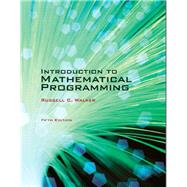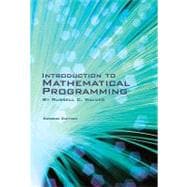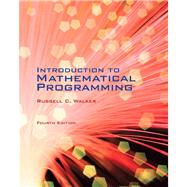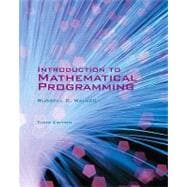Introduction to Mathematical Programming - Fifth Edition

Introduction to Mathematical Programming - Fifth Edition
- ISBN 13:
9781323578858
- ISBN 10:
1323578854
- Edition: 5th
- Format: Spiral Bound
- Copyright: 11/16/2016
- Publisher: Pearson Learning Solutions
.svg) Rent
From $95.04
Rent
From $95.04
List Price $120.00 Save
| TERM | PRICE | DUE |
|---|---|---|



List Price $120.00 Save $1.20
Usually Ships in 2-3 Business Days
We Buy This Book Back!
Free Shipping On Every Order
Note: Supplemental materials are not guaranteed with Rental or Used book purchases.
Extend or Purchase Your Rental at Any Time
Need to keep your rental past your due date? At any time before your due date you can extend or purchase your rental through your account.
Summary
The central topic of this text is linear programming and its applications. While the emphasis is on applications, it includes some material for those interested in an occasional departure into theory. The first five chapters discuss linear problems including the simplex algorithm in Chapter 3. The needed matrix algebra background is developed in Chapter 2. Chapters 6 and 7 present classical optimization and require basic differential calculus. The key elements of calculus needed are recalled at the beginning of Chapter 6.
Objectives
The first objective is to provide the background to employ mathematical programming as a managerial tool. The key step is to acquire the mind-set that allows one to recognize when a mathematical model can be useful. Even for a person who does not expect to use mathematics him or herself, it is certainly desirable to be familiar with the ideas when working with or supervising others doing the actual analysis of problems. So the ultimate objective is to acquire an attitude that appreciates the potential of the methods presented, and then to develop an understanding and ability to apply them. The second objective is to achieve some appreciation and understanding of the mathematics associated with the applied techniques. There are proofs here and there, and also an occasional excursion into topics such as basic graph theory, linear algebra, analysis, properties of algorithms, and combinatorics. While these side-trips can be largely ignored by those solely interested in applications, they could also be pointed out and amplified by the instructor who wants a course that emphasizes the mathematics.









